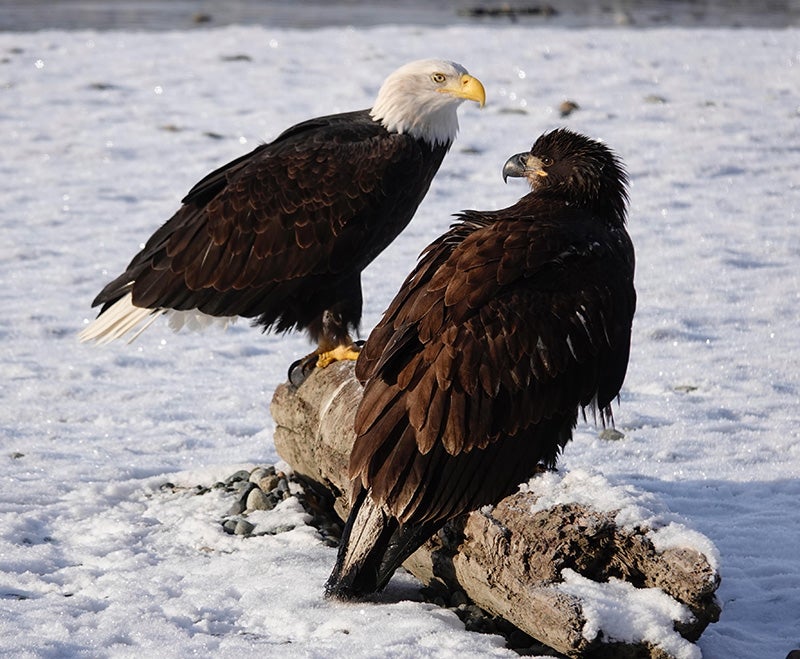Al Batt: Beavers with satisfactory swimming holes may build lodges instead
Published 9:00 am Saturday, November 17, 2018

- Bald eagles — older and younger. Al Batt/Albert Lea Tribune
Al Batt of Hartland is a member of the Albert Lea Audubon Society. Email him at SnoEowl@aol.com.
My neighbor Crandall stops by.
“How are you doing?” I say.
“Everything is nearly copacetic. I lost my mood ring. I don’t know how I feel about that. I’m glad the election is over. I voted just once this year. I know politicians keep only 6.3 percent of their promises, but I hope they are worth keeping. Maybe things will be all right. I was so busy voting only once that I haven’t had the time to do any macrame.”
“You do macrame?” I ask, changing the subject.
“I just told you that I haven’t been able to find the time to do any macrame. I’ve never been able to find the time to do any macrame.“
“How is your cold?” I say.
“One day, I was fancy free and footloose. The next day, I felt like I needed some fixing up. I finally went to see the doctor. I’d come from attending a function where I’d felt it was proper to wear a suit and tie. I’d put a flower in my lapel. I felt lousy and I must have looked worse because the doctor said I looked like a well-kept graveyard. That gets a fellow’s attention.”
Leave it to beavers
I was slaving away in Beaver Dam, Wisconsin. The city was named for a beaver dam located in a stream flowing into the Beaver Dam River. The area had been known as Okwaanim, Chippewa for beaver dam. Beaver dams are built by beavers to provide ponds as protection against predators such as coyotes, wolves and bears, and to provide access to food in winter. If lakes or rivers have deep enough water, beavers may not build dams and live in bank burrows and lodges instead. If the water isn’t deep enough to keep beavers safe from predators and the lodge entrances ice-free, beavers build dams. These structures modify the natural environment in a way that the overall ecosystem builds upon the change, making beavers a keystone species. A keystone species is one that helps define an entire ecosystem and without that species, an ecosystem would be dramatically different or cease to exist.
American Bald Eagle
Foundation
I spoke at the Bald Eagle Festival at the American Bald Eagle Foundation located in Haines, Alaska. Alaska is where folks think Texas is cute. Haines is 80 miles north of Juneau. As many as 3500 bald eagles have been found in a single count. All species of Alaska’s Pacific salmon (king, sockeye, coho, pink and chum) are caught in the Chilkat and Chilkoot Rivers. Hemlock and Sitka spruce trees predominate. Brown and black bears, wolves, coyotes, moose, mountain goats, porcupine, river otters, harbor seals, orcas and humpback whales are seen there. The 1991 movie “White Fang” was filmed in Haines as was “Gold Rush” on the Discovery Channel. The population of the Haines Borough is about 2,400 (and 1,897 dogs) in the summer, dropping to 1,800 in the winter. Haines is where the tundra and the rainforest meet. The numbers jump around depending on the source, but the average annual rainfall is approximately 48 inches with an annual snowfall of 122-130 inches. During the winter of 2011-12, 360 inches of snow fell downtown. I love seeing the mountains. I recall leading a trip to Alaska and hoping that Denali (formerly Mt. McKinley) would be visible. I arose early and delighted in seeing the highest peak in North America. I told my charges that the mountain was out. One of them asked, “Where else would it be?” I was nearly hit by a LFBE (Low Flying Bald Eagle) while birding in Haines this year.
Q&A
“Why do Canada geese like lawns?” Two reason: goose food and safety. The grass provides the food and a lawn makes it easy to detect predators.
“How much can a chipmunk stuff into its cheeks?” The eastern chipmunk is about 10 inches long including its tail. Its cheeks can stretch to three times larger than the chipmunk’s head. I’m often told that its name came from the sound that the animal makes. However, the common name may have been spelled “chitmunk” from the Odawa word jidmoonh or the Ojibwe ajidamoo. A male chipmunk is called a buck; a female is a doe; a baby is called kit, kitten or pup; and a group of chipmunks is a scurry.
Thanks for stopping by
“People take different roads seeking fulfillment and happiness. Just because they’re not on your road doesn’t mean they’ve gotten lost.” — Dalai Lama
“The thin snow now driving from the north lodges on my coat. How full of the creative genius is the air in which these flakes are generated. I could hardly more admire if real stars fell and lodged on my coat.” — Henry David Thoreau
“No shade, no shine, no butterflies, no bees, No fruits, no flowers, no leaves, no birds, November!” — Thomas Hood
Do good.

